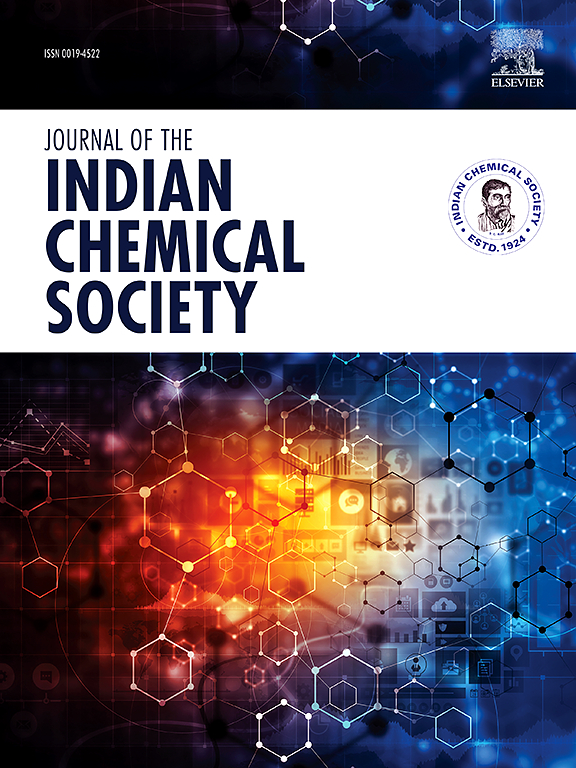Facile synthesis of nano-structured magnesium oxide via sol-gel Method: Insights into structural, electrical, and humidity sensing characteristics
IF 3.2
4区 化学
Q2 CHEMISTRY, MULTIDISCIPLINARY
引用次数: 0
Abstract
The growing electronic industry has led to widespread use of electronic devices, where environmental humidity can impact their performance. Consequently, there has been increasing interest in the development of humidity sensors to ensure optimum functionality. This work focuses on the preparation and performance of magnesium oxide nanoparticles-based humidity sensor, with nanoparticle being synthesized using sol gel method. Physical analysis of the synthesized MgO nanoparticles was done by different analytical techniques including Fourier Transform Infra-red Spectroscopy (FTIR), Field Emission Scanning Electron Microscopy (FESEM), X-ray Diffraction (XRD), X-ray Photoelectron Spectroscopy (XPS), Ultraviolet–Visible spectroscopy (UV–Vis), Thermogravimetric Analysis (TGA) and Brunauer-Emmett-Teller (BET) analysis. Average crystallite size obtained from XRD was 31 nm while particle size calculated from FESEM images was noted to be 190 nm. The band gap energy of the as prepared nanoparticles was found to be 2.78 eV with maximum absorbance at 200 nm. XPS proved the existence of Mg and O with weight percentages of 21.80 % Mg and 77.58 % O. The BET surface area was 219 m2/g, with BJH specific surface area of 134 m2/g and average pore size of 15.43 nm. The electrochemical properties were evaluated using cyclic voltammetry (CV) galvanostatic charge discharge (GCD), and electrochemical impedance spectroscopy (EIS) techniques, revealing specific capacitance values ranging from 8.66 to 90.73 F g−1, with a capacitance retention of 66 %.EIS results indicated a solution resistance of 0.87792 Ω cm2 and charge transfer resistance of 3.077 Ω cm2. Humidity sensing response was evaluated by measuring resistance changes through LCR (Q) meter. The humidity sensor demonstrated a response and recovery times of 52 s and 131 s respectively. Results of various physical parameters and applications proved that the prepared magnesium oxide could be successfully used as active materials for fine supercapacitance and humidity sensing applications.
溶胶-凝胶法快速合成纳米结构氧化镁:结构、电学和湿度传感特性
不断发展的电子工业导致电子设备的广泛使用,环境湿度会影响其性能。因此,人们对湿度传感器的发展越来越感兴趣,以确保最佳的功能。本文主要研究了氧化镁纳米颗粒湿度传感器的制备及其性能,采用溶胶-凝胶法制备了纳米颗粒。利用傅里叶变换红外光谱(FTIR)、场发射扫描电子显微镜(FESEM)、x射线衍射(XRD)、x射线光电子能谱(XPS)、紫外可见光谱(UV-Vis)、热重分析(TGA)和布鲁诺尔-埃米特-泰勒(BET)等分析技术对合成的MgO纳米颗粒进行了物理分析。XRD测得的平均晶粒尺寸为31 nm, FESEM测得的平均晶粒尺寸为190 nm。所制备的纳米粒子带隙能为2.78 eV,最大吸光度在200 nm处。XPS证实Mg和O的存在,Mg和O的质量百分比分别为21.80%和77.58%。BET比表面积为219 m2/g, BJH比表面积为134 m2/g,平均孔径为15.43 nm。利用循环伏安法(CV)、恒流充放电法(GCD)和电化学阻抗谱(EIS)技术对该材料的电化学性能进行了评价,结果表明,该材料的比电容值在8.66 ~ 90.73 F g−1之间,电容保持率为66%。EIS结果表明,溶液电阻为0.87792 Ω cm2,电荷转移电阻为3.077 Ω cm2。通过LCR (Q)计测量电阻变化来评价湿度传感响应。湿度传感器的响应时间和恢复时间分别为52 s和131 s。各种物理参数和应用结果证明,所制备的氧化镁可以成功地用作精细超级电容和湿度传感的活性材料。
本文章由计算机程序翻译,如有差异,请以英文原文为准。
求助全文
约1分钟内获得全文
求助全文
来源期刊
CiteScore
3.50
自引率
7.70%
发文量
492
审稿时长
3-8 weeks
期刊介绍:
The Journal of the Indian Chemical Society publishes original, fundamental, theorical, experimental research work of highest quality in all areas of chemistry, biochemistry, medicinal chemistry, electrochemistry, agrochemistry, chemical engineering and technology, food chemistry, environmental chemistry, etc.

 求助内容:
求助内容: 应助结果提醒方式:
应助结果提醒方式:


